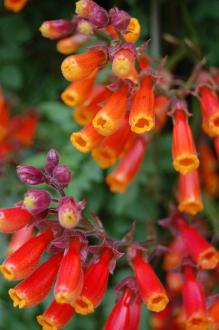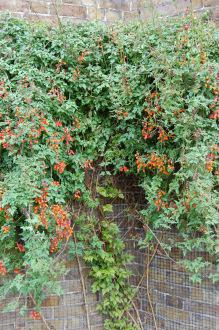
Campsis x tagliabuana Flower (05/05/2012, Kew Gardens, London)
Position: Full sun to partial shade (although flowers poorly)
Flowering period: Mid summer to early autumn (although this photo was taken in late spring)
Soil: Moist, well drained
Eventual Height: 10m
Eventual Spread: 4m
Hardiness: 6a – 9b
Family: Bignoniaceae
Campsis x tagliabuana is a large, fast growing deciduous climbing plant. Its dark green shiny leaves are alternate, pinnate, up to 30cm long and composed of up to 11 leaflets. The individual leaflets are ovate with serrated margins. Its vines are quite woody. Its orange/ red flowers are trumpet shaped, are arranged in cymes and are up to 75mm long. Its fruit is a loculicidal capsule. Its has aerial roots which cling to objects for support. This plant suckers from underground runners.
Campsis x tagliabuana, commonly known as Trumpet Vine or Trumpet Creeper, is a hybrid between Campsis radicans and Campsis grandiflora.
The etymological root of the binomial name Campsis is derived from the Greek kampe meaning ‘bent’, referring to the curved stamens of the flower. Tagliabuana is named after Tagliabue Nursery in Italy, where it was discovered.

Campsis x tagliabuana (05/05/2012, Kew Gardens, London)
The landscape architect may find Campsis x tagliabuana useful as a fast growing screening climber with very showy flowers. Although this plant does have aerial roots it will also need additional support. Space needs to be given to this plant as it is large and may spread, there are numerous reports of this plant being invasive.
Ecologically, C. x tagliabuana flowers are attractive to bees and pollinating insects. The flowers are also very attractive to humming birds.
The Royal Horticultural Society has given the variety C. x tagliabuana ‘Madame Galen’ their prestigious Award of Garden Merit in 1993.
C. x tagliabuana prefers moist, fertile, well-drained soils. It tolerates most pH of soil.
Campsis x tagliabuana requires little maintenance. Pruning may be carried out any time of the year.

